英语中表示强调的8种句式
- 格式:doc
- 大小:20.50 KB
- 文档页数:4
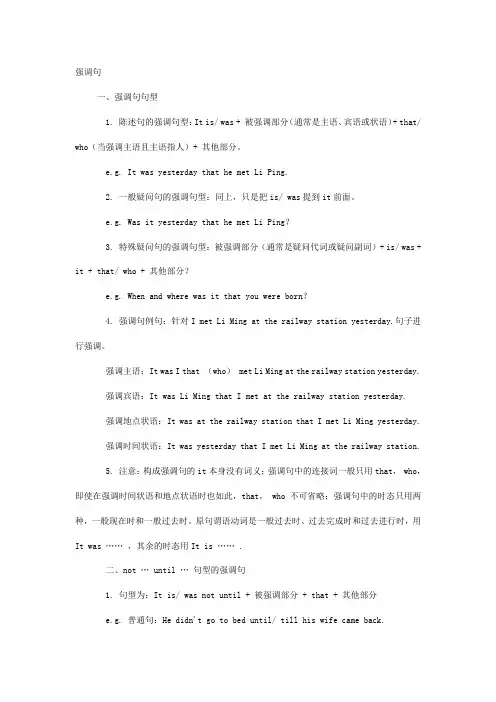
强调句一、强调句句型1. 陈述句的强调句型:It is/ was + 被强调部分(通常是主语、宾语或状语)+ that/ who(当强调主语且主语指人)+ 其他部分。
e.g. It was yesterday that he met Li Ping.2. 一般疑问句的强调句型:同上,只是把is/ was提到it前面。
e.g. Was it yesterday that he met Li Ping?3. 特殊疑问句的强调句型:被强调部分(通常是疑问代词或疑问副词)+ is/ was + it + that/ who + 其他部分?e.g. When and where was it that you were born?4. 强调句例句:针对I met Li Ming at the railway station yesterday.句子进行强调。
强调主语:It was I that (who) met Li Ming at the railway station yesterday.强调宾语:It was Li Ming that I met at the railway station yesterday.强调地点状语:It was at the railway station that I met Li Ming yesterday.强调时间状语:It was yesterday that I met Li Ming at the railway station.5. 注意:构成强调句的it本身没有词义;强调句中的连接词一般只用that, who,即使在强调时间状语和地点状语时也如此,that, who不可省略;强调句中的时态只用两种,一般现在时和一般过去时。
原句谓语动词是一般过去时、过去完成时和过去进行时,用It was …… ,其余的时态用It is …… .二、not … until … 句型的强调句1. 句型为:It is/ was not until + 被强调部分 + that + 其他部分e.g. 普通句:He didn't go to bed until/ till his wife came back.强调句:It was not until his wife came back that he went to bed.2. 注意:此句型只用until,不用till.但如果不是强调句型,till, until可通用;因为句型中It is/ was not …… 已经是否定句了,that后面的从句要用肯定句,切勿再用否定句了。
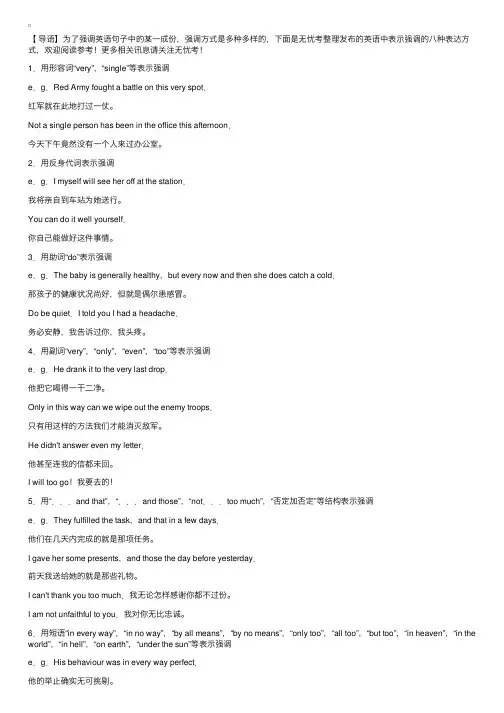
【导语】为了强调英语句⼦中的某⼀成份,强调⽅式是多种多样的,下⾯是⽆忧考整理发布的英语中表⽰强调的⼋种表达⽅式,欢迎阅读参考!更多相关讯息请关注⽆忧考!1.⽤形容词“very”,“single”等表⽰强调e.g.Red Army fought a battle on this very spot.红军就在此地打过⼀仗。
Not a single person has been in the office this afternoon.今天下午竟然没有⼀个⼈来过办公室。
2.⽤反⾝代词表⽰强调e.g.I myself will see her off at the station.我将亲⾃到车站为她送⾏。
You can do it well yourself.你⾃⼰能做好这件事情。
3.⽤助词“do”表⽰强调e.g.The baby is generally healthy,but every now and then she does catch a cold.那孩⼦的健康状况尚好,但就是偶尔患感冒。
Do be quiet.I told you I had a headache.务必安静,我告诉过你,我头疼。
4.⽤副词“very”,“only”,“even”,“too”等表⽰强调e.g.He drank it to the very last drop.他把它喝得⼀⼲⼆净。
Only in this way can we wipe out the enemy troops.只有⽤这样的⽅法我们才能消灭敌军。
He didn't answer even my letter.他甚⾄连我的信都未回。
I will too go!我要去的!5.⽤“...and that”,“...and those”,“not...too much”,“否定加否定”等结构表⽰强调e.g.They fulfilled the task,and that in a few days.他们在⼏天内完成的就是那项任务。
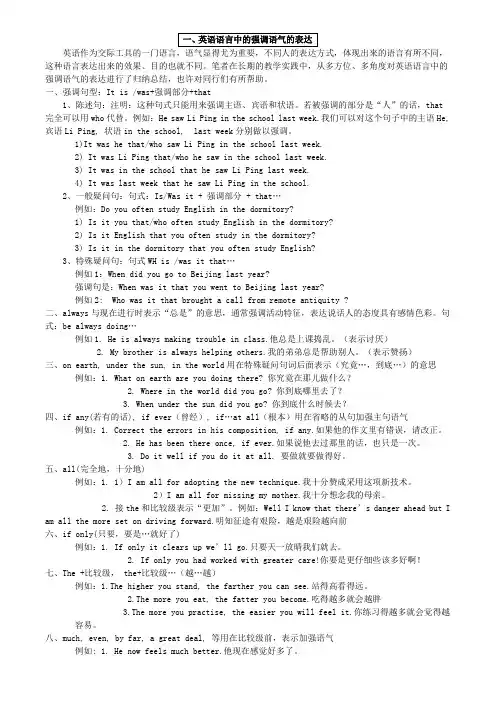
英语作为交际工具的一门语言,语气显得尤为重要,不同人的表达方式,体现出来的语言有所不同,这种语言表达出来的效果、目的也就不同。
笔者在长期的教学实践中,从多方位、多角度对英语语言中的强调语气的表达进行了归纳总结,也许对同行们有所帮助。
一、强调句型:It is /was+强调部分+that1、陈述句:注明:这种句式只能用来强调主语、宾语和状语。
若被强调的部分是“人”的话,that完全可以用who代替。
例如:He saw Li Ping in the school last week.我们可以对这个句子中的主语He, 宾语Li Ping, 状语in the school, last week分别做以强调。
1)It was he that/who saw Li Ping in the school last week.2) It was Li Ping that/who he saw in the school last week.3) It was in the school that he saw Li Ping last week.4) It was last week that he saw Li Ping in the school.2、一般疑问句:句式:Is/Was it + 强调部分 + that…例如:Do you often study English in the dormitory?1) Is it you that/who often study English in the dormitory?2) Is it English that you often study in the dormitory?3) Is it in the dormitory that you often study English?3、特殊疑问句:句式WH is /was it that…例如1:When did you go to Beijing last year?强调句是:When was it that you went to Beijing last year?例如2: Who was it that brought a call from remote antiquity ?二、always与现在进行时表示“总是”的意思,通常强调活动特征,表达说话人的态度具有感情色彩。
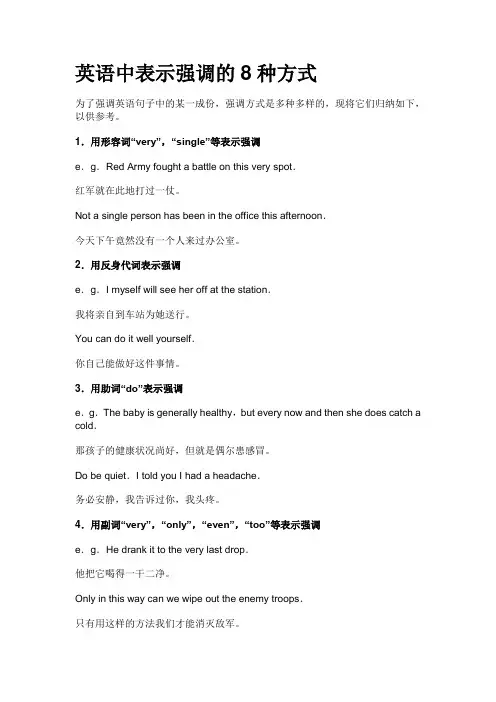
英语中表示强调的8种方式为了强调英语句子中的某一成份,强调方式是多种多样的,现将它们归纳如下,以供参考。
1.用形容词“very”,“single”等表示强调e.g.Red Army fought a battle on this very spot.红军就在此地打过一仗。
Not a single person has been in the office this afternoon.今天下午竟然没有一个人来过办公室。
2.用反身代词表示强调e.g.I myself will see her off at the station.我将亲自到车站为她送行。
You can do it well yourself.你自己能做好这件事情。
3.用助词“do”表示强调e.g.The baby is generally healthy,but every now and then she does catch a cold.那孩子的健康状况尚好,但就是偶尔患感冒。
Do be quiet.I told you I had a headache.务必安静,我告诉过你,我头疼。
4.用副词“very”,“only”,“even”,“too”等表示强调e.g.He drank it to the very last drop.他把它喝得一干二净。
Only in this way can we wipe out the enemy troops.只有用这样的方法我们才能消灭敌军。
He didn't answer even my letter.他甚至连我的信都未回。
I will too go!我要去的!5.用“...and that”,“...and those”,“not...too mu ch”,“否定加否定”等结构表示强调e.g.They fulfilled the task,and that in a few days.他们在几天内完成的就是那项任务。
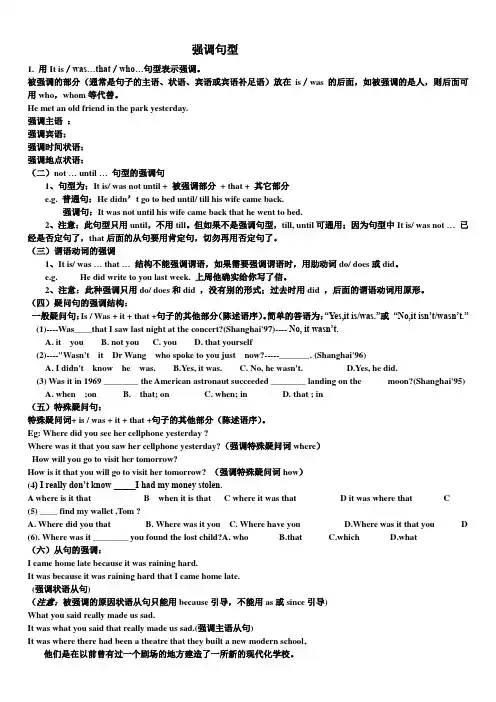
强调句型1. 用It is/was…that/who…句型表示强调。
被强调的部分(通常是句子的主语、状语、宾语或宾语补足语)放在is/was的后面,如被强调的是人,则后面可用who,whom等代替。
He met an old friend in the park yesterday.强调主语:强调宾语:强调时间状语:强调地点状语:(二)not … until …句型的强调句1、句型为:It is/ was not until + 被强调部分+ that + 其它部分e.g. 普通句:He didn’t go to bed until/ till his wife came back.强调句:It was not until his wife came back that he went to bed.2、注意:此句型只用until,不用till。
但如果不是强调句型,till, until可通用;因为句型中It is/ was not …已经是否定句了,that后面的从句要用肯定句,切勿再用否定句了。
(三)谓语动词的强调1、It is/ was … that …结构不能强调谓语,如果需要强调谓语时,用助动词do/ does或did。
e.g. He did write to you last week. 上周他确实给你写了信。
2、注意:此种强调只用do/ does和did ,没有别的形式;过去时用did ,后面的谓语动词用原形。
(四)疑问句的强调结构:一般疑问句:Is / Was + it + that +句子的其他部分(陈述语序)。
简单的答语为:“Yes,it is/was.”或“No,it isn’t/wasn’t.”(1)----Was____that I saw last night at the concert?(Shanghai'97)---- No, it wasn’t.A. it youB. not youC. youD. that yourself(2)----"Wasn't it Dr Wang who spoke to you just now?-----_______. (Shanghai'96)A. I didn't know he was.B.Yes, it was.C. No, he wasn't.D.Yes, he did.(3) Was it in 1969 ________ the American astronaut succeeded ________ landing on the moon?(Shanghai'95)A. when ;onB. that; onC. when; inD. that ; in(五)特殊疑问句:特殊疑问词+ is / was + it + that +句子的其他部分(陈述语序)。
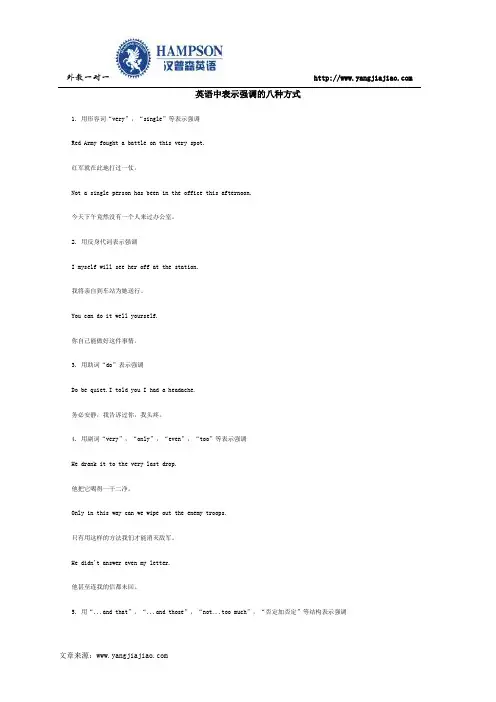
外教一对一英语中表示强调的八种方式1. 用形容词“very”,“single”等表示强调Red Army fought a battle on this very spot.红军就在此地打过一仗。
Not a single person has been in the office this afternoon.今天下午竟然没有一个人来过办公室。
2. 用反身代词表示强调I myself will see her off at the station.我将亲自到车站为她送行。
You can do it well yourself.你自己能做好这件事情。
3. 用助词“do”表示强调Do be quiet.I told you I had a headache.务必安静,我告诉过你,我头疼。
4. 用副词“very”,“only”,“even”,“too”等表示强调He drank it to the very last drop.他把它喝得一干二净。
Only in this way can we wipe out the enemy troops.只有用这样的方法我们才能消灭敌军。
He didn't answer even my letter.他甚至连我的信都未回。
5. 用“...and that”,“...and those”,“not...too much”,“否定加否定”等结构表示强调外教一对一They fulfilled the task,and that in a few days.他们在几天内完成的就是那项任务。
I gave her some presents,and those the day before yesterday.前天我送给她的就是那些礼物。
I can't thank you too much.我无论怎样感谢你都不过份。
6. 用短语“in every way”,“in no way”,“by all means”,“by no means”,“only too”,“all too”,“but too”,“in heaven”,“in the world”,“in hell”,“on earth”,“under the sun”等表示强调His behaviour was in every way perfect.他的举止确实无可挑剔。
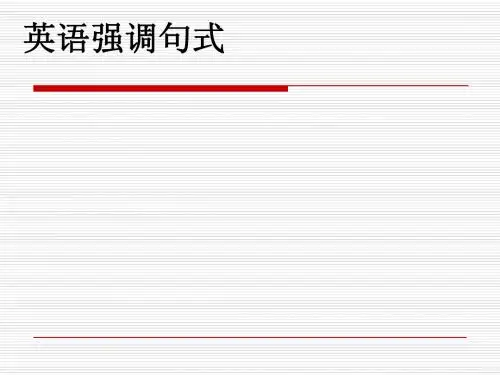
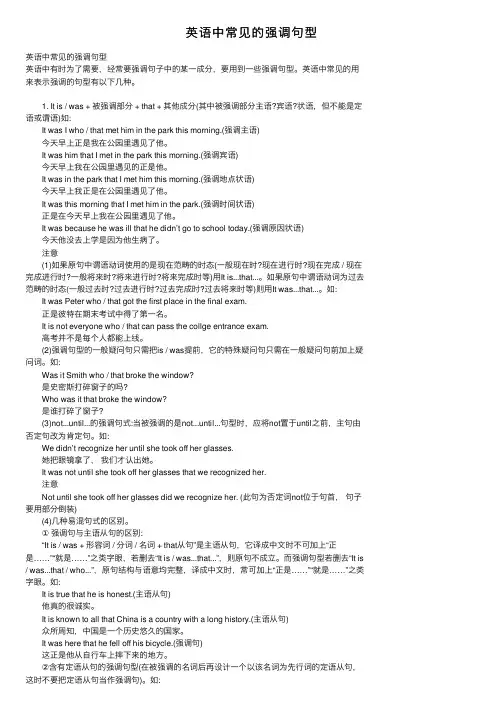
英语中常见的强调句型英语中常见的强调句型英语中有时为了需要,经常要强调句⼦中的某⼀成分,要⽤到⼀些强调句型。
英语中常见的⽤来表⽰强调的句型有以下⼏种。
1. It is / was + 被强调部分 + that + 其他成分(其中被强调部分主语?宾语?状语,但不能是定语或谓语)如: It was I who / that met him in the park this morning.(强调主语) 今天早上正是我在公园⾥遇见了他。
It was him that I met in the park this morning.(强调宾语) 今天早上我在公园⾥遇见的正是他。
It was in the park that I met him this morning.(强调地点状语) 今天早上我正是在公园⾥遇见了他。
It was this morning that I met him in the park.(强调时间状语) 正是在今天早上我在公园⾥遇见了他。
It was because he was ill that he didn’t go to school today.(强调原因状语) 今天他没去上学是因为他⽣病了。
注意 (1)如果原句中谓语动词使⽤的是现在范畴的时态(⼀般现在时?现在进⾏时?现在完成 / 现在完成进⾏时?⼀般将来时?将来进⾏时?将来完成时等)⽤It is...that...。
如果原句中谓语动词为过去范畴的时态(⼀般过去时?过去进⾏时?过去完成时?过去将来时等)则⽤It was...that...。
如: It was Peter who / that got the first place in the final exam. 正是彼特在期末考试中得了第⼀名。
It is not everyone who / that can pass the collge entrance exam. ⾼考并不是每个⼈都能上线。
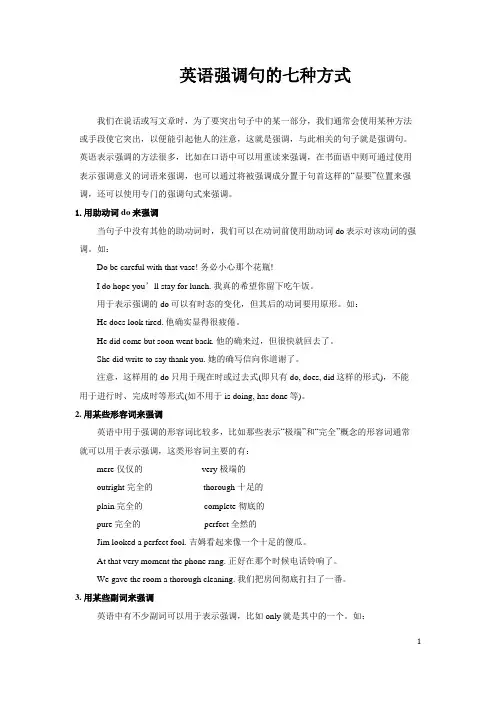
英语强调句的七种方式我们在说话或写文章时,为了要突出句子中的某一部分,我们通常会使用某种方法或手段使它突出,以便能引起他人的注意,这就是强调,与此相关的句子就是强调句。
英语表示强调的方法很多,比如在口语中可以用重读来强调,在书面语中则可通过使用表示强调意义的词语来强调,也可以通过将被强调成分置于句首这样的“显要”位置来强调,还可以使用专门的强调句式来强调。
1.用助动词do来强调当句子中没有其他的助动词时,我们可以在动词前使用助动词do表示对该动词的强调。
如:Do be careful with that vase! 务必小心那个花瓶!I do hope you’ll stay for lunch. 我真的希望你留下吃午饭。
用于表示强调的do可以有时态的变化,但其后的动词要用原形。
如:He does look tired. 他确实显得很疲倦。
He did come but soon went back. 他的确来过,但很快就回去了。
She did write to say thank you. 她的确写信向你道谢了。
注意,这样用的do只用于现在时或过去式(即只有do, does, did这样的形式),不能用于进行时、完成时等形式(如不用于is doing, has done等)。
2. 用某些形容词来强调英语中用于强调的形容词比较多,比如那些表示“极端”和“完全”概念的形容词通常就可以用于表示强调,这类形容词主要的有:mere 仅仅的 very 极端的outright 完全的 thorough 十足的plain 完全的 complete 彻底的pure 完全的 perfect 全然的Jim looked a perfect fool. 吉姆看起来像一个十足的傻瓜。
At that very moment the phone rang. 正好在那个时候电话铃响了。
We gave the room a thorough cleaning. 我们把房间彻底打扫了一番。
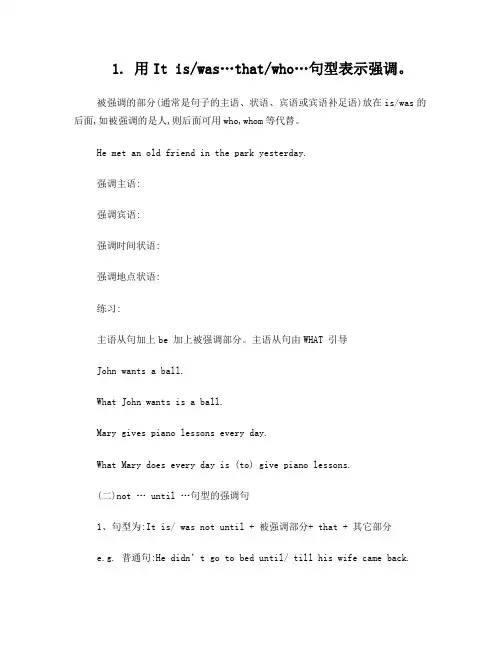
1. 用It is/was…that/who…句型表示强调。
被强调的部分(通常是句子的主语、状语、宾语或宾语补足语)放在is/was的后面,如被强调的是人,则后面可用who,whom等代替。
He met an old friend in the park yesterday.强调主语:强调宾语:强调时间状语:强调地点状语:练习:主语从句加上be 加上被强调部分。
主语从句由WHAT 引导John wants a ball.What John wants is a ball.Mary gives piano lessons every day.What Mary does every day is (to) give piano lessons.(二)not … until …句型的强调句1、句型为:It is/ was not until + 被强调部分+ that + 其它部分e.g. 普通句:He didn’t go to bed until/ till his wife came back.强调句:It was not until his wife came back that he went to bed.2、注意:此句型只用until,不用till。
但如果不是强调句型,till, until可通用;因为句型中It is/ was not …已经是否定句了,that后面的从句要用肯定句,切勿再用否定句了。
(三)谓语动词的强调1、It is/ was … that …结构不能强调谓语,如果需要强调谓语时,用助动词do/ does 或did。
e.g. Do sit down. 务必请坐。
He did write to you last week. 上周他确实给你写了信。
Do be careful when you cross the street. 过马路时,务必(千万)要小心啊!2、注意:此种强调只用do/ does和did ,没有别的形式;过去时用did ,后面的谓语动词用原形。
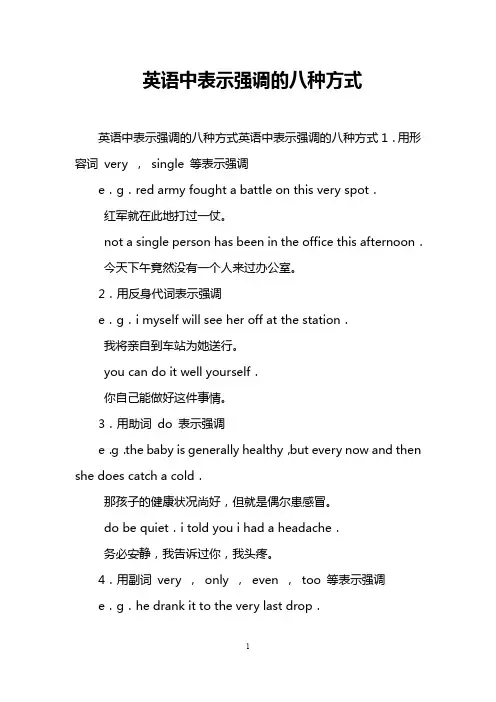
英语中表示强调的八种方式英语中表示强调的八种方式英语中表示强调的八种方式1.用形容词very ,single 等表示强调e.g.red army fought a battle on this very spot.红军就在此地打过一仗。
not a single person has been in the office this afternoon.今天下午竟然没有一个人来过办公室。
2.用反身代词表示强调e.g.i myself will see her off at the station.我将亲自到车站为她送行。
you can do it well yourself.你自己能做好这件事情。
3.用助词do 表示强调e.g.the baby is generally healthy,but every now and then she does catch a cold.那孩子的健康状况尚好,但就是偶尔患感冒。
do be quiet.i told you i had a headache.务必安静,我告诉过你,我头疼。
4.用副词very ,only ,even ,too 等表示强调e.g.he drank it to the very last drop.他把它喝得一干二净。
only in this way can we wipe out the enemy troops.只有用这样的方法我们才能消灭敌军。
he didn't answer even my letter.他甚至连我的信都未回。
i will too go!我要去的!5.用...and that ,...and those ,not...too much ,否定加否定等结构表示强调e.g.they fulfilled the task,and that in a few days.他们在几天内完成的就是那项任务。
i gave her some presents,and those the day before yesterday.前天我送给她的就是那些礼物。
强调句型1. 用It is/was…that/who…句型表示强调;被强调的部分通常是句子的主语、状语、宾语或宾语补足语放在is/was的后面,如被强调的是人,则后面可用who,whom等代替;He met an old friend in the park yesterday.强调主语:强调宾语:强调时间状语:强调地点状语:二not … until …句型的强调句1、句型为:It is/ was not until + 被强调部分+ that + 其它部分. 普通句:He didn’t go to bed until/ till his wife came back.强调句:It was not until his wife came back that he went to bed.2、注意:此句型只用until,不用till;但如果不是强调句型,till, until可通用;因为句型中It is/ was not …已经是否定句了,that后面的从句要用肯定句,切勿再用否定句了;三谓语动词的强调1、It is/ was … that …结构不能强调谓语,如果需要强调谓语时,用助动词do/ does或did;. He did write to you last week. 上周他确实给你写了信;2、注意:此种强调只用do/ does和did ,没有别的形式;过去时用did ,后面的谓语动词用原形;四疑问句的强调结构:一般疑问句:Is / Was + it + that +句子的其他部分陈述语序;简单的答语为:“Yes,it is/was.”或“No,it isn’t/wasn’t.”1----Was____that I saw last night at the concertShanghai'97---- No, it wasn’t.A. it youB. not youC. youD. that yourself2----"Wasn't it Dr Wang who spoke to you just now-----_______. Shanghai'96A. I didn't know he was. , it was. C. No, he wasn't. , he did.3 Was it in 1969 ________ the American astronaut succeeded ________ landing on the moonShanghai'95A. when ;onB. that; onC. when; inD. that ; in五特殊疑问句:特殊疑问词+ is / was + it + that +句子的其他部分陈述语序;Eg: Where did you see her cellphone yesterdayWhere was it that you saw her cellphone yesterday强调特殊疑问词whereHow will you go to visit her tomorrowHow is it that you will go to visit her tomorrow 强调特殊疑问词how4 I really don’t know _____I had my money stolen.A where is it thatB when it is thatC where it was thatD it was where that C5 ____ find my wallet ,TomA. Where did you thatB. Where was it youC. Where have you was it that you D6. Where was it ________ you found the lost childA. who六从句的强调:I came home late because it was raining hard.It was because it was raining hard that I came home late.强调状语从句注意:被强调的原因状语从句只能用because引导,不能用as或since引导What you said really made us sad.It was what you said that really made us sad.强调主语从句It was where there had been a theatre that they built a new modern school.他们是在以前曾有过一个剧场的地方建造了一所新的现代化学校;7 It was how the young man had learned five foreign languages ______attracted the audience's interest.A. so that which8. It was only when I reread his poems recently ________ I began to appreciate their beauty.A. untilB. that9_____the people ____have become the masters of their country_____science can really serve the people.is only when ; that; where B They are;/;when is only when; / ;that D It was when;that;then二、强调句型的判断把“It, be,that”去掉,如果剩余部分句子结构仍然完整被强调部分要还原到原位置,那么这个句子就是强调句;如果句子不完整,则不是强调句;如:1①It is he who / that often helps me with my English.②It is on the hillside that we plant trees every year.③It was because of bad weather that the football match had to be put off.Shanghai 2003, spring分析:去掉It is / was... that / who 句子后结构仍然完整,句意仍明确,都是强调句;④It was 9 o'clock when we came back.我们回来时是九点钟;⑤It was 3 hours since we had come back.我们回来已三个小时了;分析:在上面例句中若去掉It was... when / before / since等后,句子结构就不完整,所以不是强调句;2①It was at the theatre _________ Lincoln was murdered.It was the theatre _________ Lincoln was murdered.A. whichB. thatC. whereD. the one②It was our teacher ________did the experiment in the lab last night.A. whomB. thatC. whichD. where③It was ten years ago________ Miss Gao returned to China.A. thatB. whenC. sinceD. as④It was ________ he said ______disappointed me.Shanghai'99A. what; that ; that C. what; what ; what⑤It was for this reason ________ her uncle moved out of New York and settled down in a small village.Shanghai 2001, springA. which三、强调句型几注意首先,我们按强调句的语序来总结强调句的五项注意:1. 句首词用“It”,不能用“This”,“That”等;2. be动词的形式是is或was,不能用复数形式are或were;若原句的谓语动词用了现在时或将来时,则用is;若原句的谓语动词用了过去时或过去完成时,则用was.Eg:1 It___the Chinese women that___a great role in the socialist construction.A is;playsB are;playC is;playD are;plays2 ___all these exercises____all of us can do tomorrow.A. It is;thatB. It was;that C They are;which D It will be;that3. 被强调的部分如果是代词,强调主语用主格,强调宾语用宾格;如:1It is him that/who /whom I met in the street yesterday.2It is I who/that am wrong.4. 连接词一般用that,当强调部分是人时,既可用that也可用who.特别注意当强调部分是时间状语或地点状语时,不能用when或where;Eg: It was on Oct 1st, 1949 that People’s Republic of China was founded.It was at the gate ________ he told me the news.MET'88A. that5. 主谓一致问题被强调的主语要和that后面的谓语动词在数上保持一致;8It is Mary who often_____ help me with my English.9It is I that ____beagainst you.10It is the boy students of Class Two who ___beplaying football on the playground.11It is Mr Green ,together with his wife and children ,that____in China now.A areB isC wasD were12It was neither you nor he that___to blame for the mistake.… until 结构的强调:强调“not…until”引导的时间状语时,要用“it is/was not until…that…”结构,,that后面的句子要用肯定式,且须用陈述句语序;Eg: 13 We did not get off the bus until it stopped .It was not until it stopped that we got off the bus.注意:强调该结构时not until不能分开14It was not until 1920___ regular radio broadcast began. NMET95A. whileB. whichC. thatD. since15It was not ____ she took off her dark glasses ____ I realized she was a famous film star. 1992A. when; thatB. until; that C .until; when D. when; then16 It was ________ back home after the experiment.A. not until midnight did he goB. until midnight that he didn't goC. not until midnight that he wentD. until midnight when he didn't go17It was not until ________ that ________ to prepare his lessons.Shanghai'91A. did his father come in; the boy beganB. his father came in; the boy beganC. did his father come in; did the boy beginD. his father came in did the boy begin7.强调时间状语和地点状语时与定语从句的区别:18It was in 1921 that our Party was founded.强调句式19It was 1921 when our Party was founded.定语从句20 It was on the farm that we practised planting crops. = We practised planting crops on the farm.21 It was the farm where we learned a lot .22 It was at the street corner that I met Lucy yesterday.= I met Lucy at the street corner yesterday23 It was the street corner where I met Lucy yesterday.24 Was it in this palace ________ the last emperor died MET88A. thatB. in which where8. 强调句型与主语从句的区别:强调句型可以还原成正常语序的句子,也就是说,强调句型中去掉It be… that后,句子仍然通顺,意义也依然完整,只是没有那么强调突出;而含主语从句的复合句中的it是指示代词,后面多为系表结构或被动语态;如果去掉It be…that,句子就不通顺了;如:It was in the lab that was taken charge by Professor Harris that they did the experiment.=They did the experiment in the lab that was taken charge by Professor Harris.It is certain that he is honest and modest.很显然,他是诚实而谦虚的;It is known to all that paper was made first in China.众所周知,纸是中国人最早制造出来的;Ddodoes/did引出强调句1.在谓语动词之前通常是现在时和过去时的句子,可用助动词dodoes/did来强调动词,这时谓语动词须用原形动词;Dodoes/did可译成“确实”“的确”;To my great joy,, the plant did look exactly like what we were looking for.He does work hard and finish the job in time.2.在肯定的祈使句中,用动词do来加强语气,可译成“务必,一定,千万”Do come and see us some day.Do give her my regards.1. ____ she first heard of the man referred to as a specialist.A That was from StephenB It was Stephen whomC It was from Stephen that was Stephen that2. When I try to understand ____ that prevents so many Americans from being as happy as one expect, it seems to me that there are two causes.A. why it doesB. what it doesC. what it isD. why it iswas ______ the next morning that I began to think about where I was going.A. beforeB. afterC. whenD. not until4. It ______ her brother ______ she will borrow the money.A. is from…thatB. is from…whoC. is…whomD. is…that强调句型易错点It was only with the help of the local guide .the mountain climber rescued the mountain climber was rescuedthe mountain climber was rescued the mountain climber was rescued历年有关强调句的考题:1.09江西27. It was _____ he came bank from Africa _________ he met the girl he would like to marry.A. when; thenB. not; untilC. not until; thatD. only; when2.09浙江卷4.——I’ve read another book this week.——Well, maybe is not how much you read but what you read that counts.A. .thisB. thatC. thereD. it3.09全国2卷17. It is often that human beings are naturally equipped to speak.A. saidB. to sayC. sayingD. being said4.09浙江7.-I’ve read another book this week.-Well, maybe _____ is not how much you read but what you read that counts.A. thisB. thatC. thereD. it考点1、强调部分从短语向句子过渡;It is what you do rather than what you say________matters.A. thatB. whatC. whichD. this考点2、强调句从肯定句向否定句、一般疑问句和特殊疑问句过渡;强调句的否定句形式为:It is / was not + 被强调部分+ that / who ...强调句的一般疑问句形式为:Is / Was it +被强调部分+ that / who ...强调句的特殊疑问句形式为:疑问词+ is / was it + that / who ...1. Was it in 1969________the American astronaut succeeded________landing on the moonA. when; onB. that; onC. when; inD. that; in2. —________ that he managed to get the information —Oh, a friend of his helped him.A. Where was itB. What was itC. How was itD. Why was it考点3、从考查单一的强调句到把强调句置于从句中,增加判断句子的难度;David said that it was because of his strong interest in literature________he chose the course.A. thatB. whatC. whyD. how考点4、干扰因素增多,增加了与其它相似句型的辨析,尤其是it开头的句子;考查强调句与非强调句的辨别1. 设置陷阱,使考生将强调句误判为非强调句;如:It might have been John ______ bought a present for Mary yesterday.A. thatB. whenC. whatD. which2. 设置陷阱,使考生将非强调句误判为强调句;如:It was evening we reached the little town of Winchester.A. thatB. untilC. sinceD. before。
英语中表示“强调”的方法大总结.doc英语中表示"强调"的方法大总结引言在英语写作和口语中,强调是一种重要的修辞手段,用于突出句子中的某个部分,以吸引读者或听众的注意力。
本文档将总结英语中常用的表示强调的方法。
一、倒装句倒装句通过改变句子的正常语序来强调某个成分。
例子Only after finishing his homework did he go out to play.Not until I got home did I realize I had forgotten my keys. 二、强调句强调句通过倒装结构或某些特定词语来突出句子中的某个部分。
例子It was in the library that I found the book I was looking for. What she needs is a good rest.三、副词使用副词,如very, really, only, even, still等,可以强调句子中的某个成分。
例子She is very intelligent.He only eats vegetables.四、重复通过重复某个词语或短语,可以强调其重要性。
例子Believe it or not, it's true.I can't emphasize this enough: safety is paramount.五、比较结构使用比较级和最高级形容词或副词,可以强调两个或多个事物之间的差异。
例子She is the tallest girl in the class.This is the most interesting book I've ever read.六、双重否定双重否定可以用于强调肯定意义。
例子I can't say I don't like it.There's not a single reason why you shouldn't go.七、条件句使用条件句,如if only, would that等,可以表达强烈的愿望或假设。
表示强调的几种方式为了强调英语句子中的某一成份,强调方式是多种多样的,现将它们归纳如下,以供参考。
1.用形容词“very”,“single”等表示强调e.g.Red Army fought a battle on this very spot.红军就在此地打过一仗。
Not a single person has been in the office this afternoon.今天下午竟然没有一个人来过办公室。
2.用反身代词表示强调e.g.I myself will see her off at the station.我将亲自到车站为她送行。
You can do it well yourself.你自己能做好这件事情。
3.用助词“do”表示强调e.g.The baby is generally healthy,but every now and then she does catch a cold.那孩子的健康状况尚好,但就是偶尔患感冒。
Do be quiet.I told you I had a headache.务必安静,我告诉过你,我头疼。
4.用副词“very”,“only”,“even”,“too”等表示强调e.g.He drank it to the very last drop.他把它喝得一干二净。
Only in this way can we wipe out the enemy troops.只有用这样的方法我们才能消灭敌军。
He didn't answer even my letter.他甚至连我的信都未回。
I will too go!我要去的!5.用“...and that”,“...and those”,“not...too much”,“否定加否定”等结构表示强调e.g.They fulfilled the task,and that in a few days.他们在几天内完成的就是那项任务。
英语中表示强调的8种方式为了强调英语句子中的某一成份,强调方式是多种多样的,现将它们归纳如下,以供参考。
1.用形容词“very”,“single”等表示强调e.g.Red Army fought a battle on this very spot.红军就在此地打过一仗。
Not a single person has been in the office this afternoon.今天下午竟然没有一个人来过办公室。
2.用反身代词表示强调e.g.I myself will see her off at the station.我将亲自到车站为她送行。
You can do it well yourself.你自己能做好这件事情。
3.用助词“do”表示强调e.g.The baby is generally healthy,but every now and then she does catch a cold.那孩子的健康状况尚好,但就是偶尔患感冒。
Do be quiet.I told you I had a headache.务必安静,我告诉过你,我头疼。
4.用副词“very”,“only”,“even”,“too”等表示强调e.g.He drank it to the very last drop.他把它喝得一干二净。
Only in this way can we wipe out the enemy troops.只有用这样的方法我们才能消灭敌军。
He didn't answer even my letter.他甚至连我的信都未回。
I will too go!我要去的!5.用“...and that”,“...and those”,“not...too much”,“否定加否定”等结构表示强调e.g.They fulfilled the task,and that in a few days.他们在几天内完成的就是那项任务。
强调句和经典句型我们在说话、写文章的过程中,为了要突出句子中的某一部分时,就常使用某种方法、手段使它突出,以便能引起他人的注意,这就是强调。
英语中,表示强调的方法一般分为三种:位置的强调;用词强调;句型强调。
如:一、位置强调英语句子的语序,一般为:主、谓、宾、表、状。
有时为了强调某个成份,就故意将它移到句首或句末。
如:A. 强调主语及状语。
如:(1) I was reading English this morning. — This morning, I was reading English. 今天早晨,我一直在读英语。
(2) I’ll go to see Li Lei tomorrow. —Tomorrow, I’ll go to see Li Lei. 明天,我要去看李蕾。
B. 强调谓语(as, though引导的让步状语从句)(1) Though he will try, he can’t succeed. —Try as / though he will, he can’t succeed. 尽管他会尝试,但他不会成功。
(2)Though she can sing, she can’t sing well. —Sing though / as she can, she can’t sing well. 尽管她会唱,但唱得不好。
C. 强调宾语或表语(as, though引导的让步状语从句)(1) Though he learnt English, he didn’t learn it well. —English as / though he learnt, he didn’t learn it well. 尽管他学过英语,但他学得并不好。
(2) Though he is ill, he keeps on working. —Ill as / though he is, he keeps on working. 尽管他有病,他仍坚持工作。
英语中表示强调的8种句式
为了强调英语句子中的某一成份,强调方式是多种多样的,以下是整理的英语中表示强调的8种句式,供大家学习和参阅。
1.用形容词“very”,“single”等表示强调
e.g.Red Army fought a battle on this very spot.
红军就在此地打过一仗。
Not a single person has been in the office this afternoon.
今天下午竟然没有一个人来过办公室。
2.用反身代词表示强调
e.g.I myself will see her off at the station.
我将亲自到车站为她送行。
You can do it well yourself.
你自己能做好这件事情。
3.用助词“do”表示强调
e.g.The baby is generally healthy,but every now and then she does catch a cold.
那孩子的健康状况尚好,但就是偶尔患感冒。
Do be quiet.I told you I had a headache.
务必安静,我告诉过你,我头疼。
4.用副词“very”,“only”,“even”,“too”等表示强调
e.g.He drank it to the very last drop.
他把它喝得一干二净。
Only in this way can we wipe out the enemy troops.
只有用这样的方法我们才能消灭敌军。
He didn't answer even my letter.
他甚至连我的信都未回。
I will too go!我要去的!
5.用“...and that”,“...and those”,“not...too much”,“否定加否定”等结构表示强调
e.g.They fulfilled the task,and that in a few days.
他们在几天内完成的就是那项任务。
I gave her some presents,and those the day before yesterday.
前天我送给她的就是那些礼物。
I can't thank you too much.我无论怎样感谢你都不过份。
I am not unfaithful to you.我对你无比忠诚。
6.用短语“in every way”,“in no way”,“by all means”,“by no means”,“only too”,“all too”,“but too”,“in heaven”,“in the world”,“in hell”,“on earth”,“under the sun”等表示强调
e.g.His behaviour was in every way perfect.
他的举止确实无可挑剔。
By all means take your son with you.
你一定要把儿子带来。
The news was only too true.
这消息确实是事实。
It was over all too soon!
此事的确了结得很快!
Where in heaven were you then?
当时你到底在哪里?
Nobody under the sun would buy that car.
确实没有人会买那辆车。
7.用倒装句表示强调
e.g.Dishonest he is!他的确不诚实!
In wine is the truth. 酒后吐真言。
8.用强调句型表示强调
e.g.It was the headmaster who opened the door for me. 正是校长为我开的门。
It was yesterday that we carried out that experiment.
就是在昨天我们做了那个实验。